Skywave 1/700 Japanese Subchaser
|
KIT #: |
W-18 |
|
PRICE: |
$16.98 |
|
DECALS: |
multiple options |
|
REVIEWER: |
Tim Reynaga |
|
NOTES: |
Kit also includes two Gato subs and two
B-24s |
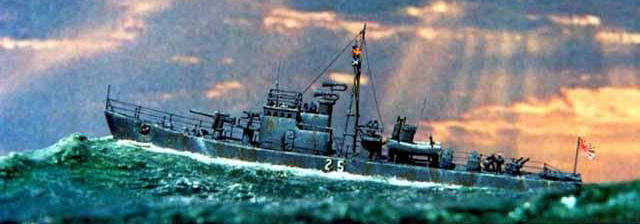
Among
the most capable navies at the outset of the Second World War, the Japanese
Combined Fleet was nevertheless dangerously deficient in its antisubmarine
warfare capability. This was due in part to limited resources, but also to the
Japanese code of Bushido
(the “Way of the Warrior”) which reveled in aggression and celebrated the attack
but in general viewed defense with disdain.
Japanese Naval weapons systems tended to reflect this;
Imperial Japan produced the most powerful battleships, carriers, and submarines
of the day, and their offensive carrier tactics and “long lance” torpedoes led
the world.
Yet basic
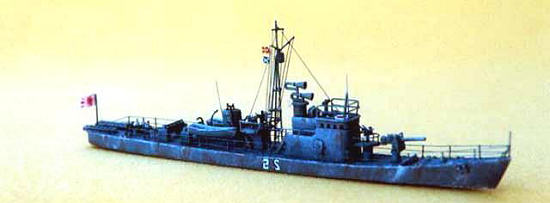 defensive systems such as radar, antiaircraft artillery
and especially antisubmarine capability remained relatively primitive.
All these shortcomings were to cost Japan dearly, but
the antisubmarine deficiencies would be the worst: during the Pacific War over
55% of all Japanese ships lost were to fall to submarine attack.
defensive systems such as radar, antiaircraft artillery
and especially antisubmarine capability remained relatively primitive.
All these shortcomings were to cost Japan dearly, but
the antisubmarine deficiencies would be the worst: during the Pacific War over
55% of all Japanese ships lost were to fall to submarine attack.
The No. 13 class
subchasers were typical of Japan’s halfhearted response to submarine defense.
Designed
primarily for the escort of small coastal convoys, these vessels were small,
slow, and almost entirely unarmored. They were nevertheless exceptionally
seaworthy and were to serve throughout the war in all operational areas from the
Aleutians to the Solomons. Intended to supplement rather than to replace full
sized destroyers, these tiny ships increasingly found themselves the sole
protectors of vital convoys as the chronic shortage of fleet destroyers became
more acute. Unequal to this demanding task, these little ships suffered
staggering losses: by the end of the war 36 of the 48 vessels of this type had
been sunk.
One
of those lost was Subchaser No. 25.
Ironically she was sunk by the submarine USS
Grunion off the North Pacific island of Kiska on July 15, 1942.
No doubt at least some of her crew survived the
torpedoing, but when No. 26 searched the area the next day there were no
survivors to be found in the frigid water.
This
subchaser was part of a 1980s Skywave/Pit-Road combo kit (kit W-18) which
included two USN Gato/Balao class subs, two Japanese No. 13 class subchasers,
and two B-24 bombers. Originally sold by Green Max in Japan, the set was
later marketed in the U.S by Skywave/Pit Road and most recently by Tamiya, who
now sell the kit with new box art under their own label (kit 903).
All of the models in the set are quite good, and the subchasers are
especially nice.
These are traditional waterline, and accurately capture the
graceful clipper bows of the originals.
Surface details
and depth charges on these are delicately rendered, but the heavy mast, davits,
and gun platforms seem to overwhelm the less than 3 inch long hulls.
Decals are
provided for all the models including alternate markings and US and IJN flags.
Interestingly,
Tamiya also makes a No.13 class subchaser of their own tooling which they
include with their Japanese Auxiliaries set (kit 519).
An entirely new effort, that subchaser is noticeably
different than the older Skywave/Pit-Road version found in this set. Fittings
are better, details a little sharper, and it seems to be more dimensionally
accurate as well. Still,
I liked the older Skywave kit very much.
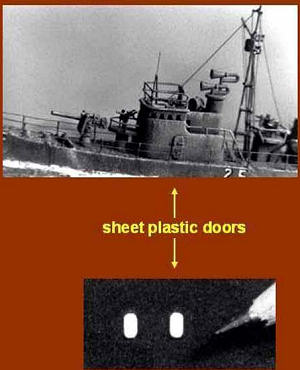 I built this model back in the early 1980s at a time when there were
very few smaller vessels available in 1/700 scale.
It was also before photoetch rails became available, so
this entire project was completed without photoetch.
Adding scale details to kits this small can be a
challenge, but I suppose I was looking for a good excuse to put off studying for
my high school finals!
I began by adding the doors to the sides of the
superstructure which appear so prominently in photos of these ships. These were
fashioned from .010 inch plastic stock with hinges made from binder paper. Next
I added two small anchors (and I do mean small—these things measured about 1/32
of an inch high!) borrowed from Hasegawa's I-168 submarine kit. Molded onto the
submarine's hull, I had to destroy the sub to remove them. I hated to cut up
such a fine kit for parts, but I figured it was worth it. The absence of anchors
on the subchaser's hull was just too noticeable, and the tiny anchors look fine
mounted beneath the hawsepipes.
I built this model back in the early 1980s at a time when there were
very few smaller vessels available in 1/700 scale.
It was also before photoetch rails became available, so
this entire project was completed without photoetch.
Adding scale details to kits this small can be a
challenge, but I suppose I was looking for a good excuse to put off studying for
my high school finals!
I began by adding the doors to the sides of the
superstructure which appear so prominently in photos of these ships. These were
fashioned from .010 inch plastic stock with hinges made from binder paper. Next
I added two small anchors (and I do mean small—these things measured about 1/32
of an inch high!) borrowed from Hasegawa's I-168 submarine kit. Molded onto the
submarine's hull, I had to destroy the sub to remove them. I hated to cut up
such a fine kit for parts, but I figured it was worth it. The absence of anchors
on the subchaser's hull was just too noticeable, and the tiny anchors look fine
mounted beneath the hawsepipes.
Other improvements included replacing various kit parts with better ones
from Skywave's "Equipment for the Japan Navy Ship-WWII, set 1." These parts kits
are still available and are definitely worthwhile. Though a bit expensive, these
replacement sets are of excellent quality and provide enough spares to last for
years (I'm still using parts from that particular set). I applaud Skywave for
this unique and innovative effort. Replacements included the searchlight on the
superstructure, the cutters, and the type 22 "horns" radar unit. These fittings
were distinct improvements over their kit provided counterparts.
In addition to this I improved some of the kit parts, especially the
armament. The 80mm deck gun, for example, received a new copper wire barrel and
a sheet plastic shield. The 13.2mm antiaircraft guns were improved with wire
barrels, plastic shields and wire shoulder brackets. The depth charge racks on
the fantail received wire rails.
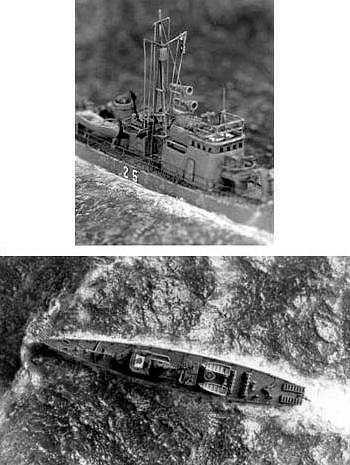 I also added a number of scratchbuilt improvements. The mast was
replaced with one fashioned from copper wire bonded with white glue, with the
crow's nest taken from the kit part. The signal flags were made from painted
binder paper. The rigging and UHF areial atop the bridge were made from
superfine wire taken from a transistor raidio coil. The safety rails on the
superstructure and around the AA gun positions were made from copper wire and
attached with white glue. These were then hand painted using a 000 brush. This
paint not only gives these assemblies the appropriate color but strengthens the
delicate joints as well. I made the galley stovepipe along the funnel in the
same way.
I also added a number of scratchbuilt improvements. The mast was
replaced with one fashioned from copper wire bonded with white glue, with the
crow's nest taken from the kit part. The signal flags were made from painted
binder paper. The rigging and UHF areial atop the bridge were made from
superfine wire taken from a transistor raidio coil. The safety rails on the
superstructure and around the AA gun positions were made from copper wire and
attached with white glue. These were then hand painted using a 000 brush. This
paint not only gives these assemblies the appropriate color but strengthens the
delicate joints as well. I made the galley stovepipe along the funnel in the
same way.
The safety rails along the main deck were probably the single most
difficult addition. These were made by cutting 28 copper wire stanchions, each
1/16 of an inch high. Along with a flagstaff and jackstaff, they were set along
the perimeter of the deck with white glue. It was important that all 28
stanchions be exactly the same length so that the safety lines to come would fit
properly, making a smooth line. To do this I lined up nine or ten 1 inch lengths
of wire and, following a prototype, made multiple copies with each cut. This
assured not only uniform accuracy but was quite a bit faster than cutting them
individually.
After this I carefully laid the ultrafine wire along them, two strands
on each side. These were attached with thinned white glue applied stanchion by
stanchion using a fine brush. I painted the wire a gray slightly lighter than
the hull color. This was to hint at the effect of salt spray and to help them
stand out better against the darker gray deck. This method is basically the same
construction as that on the real ship and captures the delicacy of the small
scale well. It is, however, a tedious and time consuming process. I had the
patience to get through a less than 3 inch long subchaser - but I would not want
to try this for a battleship!
Basic painting this model was simplicity itself.
The overall color of the original vessel (hull, decks,
masts, weapons, and other equipment) was “Yokosuka Gray”, a medium-dark gray.
This was before I had my first airbrush, so the model
was entirely brush painted by hand.
The paint used was Pactra Hot Rod Primer enamel, right
out of the bottle.
Weathering was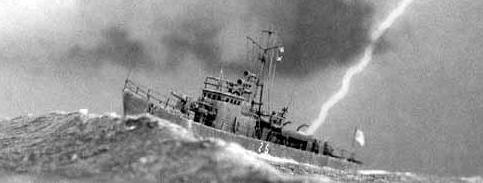 suggested with touches of white and
medium brown.
suggested with touches of white and
medium brown.
The
decals, applied after assembly and painting, were not those provided in the kit.
The
hull number "25" was from a Super Scale set for 1/285 Micro Armor.
The shaded
effect was achieved by superimposing a white "25" over a black "25," slightly
offset. The
Japanese flag on the bridge top was from a 1/76 scale tank.
Although I
cannot document that Subchaser No. 25 had this marking, I took a calculated risk
and applied it anyway. Such
markings were commonly used as an aerial recognition measure on Japanese
warships, and it is quite possible that No. 25 had it as well.
Anyway, it adds
a welcome bit of color to the otherwise plain model.
In order to
display the subchaser in a natural setting, I sculpted a sea base for it using
drywall repair spackle, mixed thick. To emphasize the seaworthiness for which
these small ships were noted I made the sea very rough, as it might have
appeared in a stormy North Pacific. The sea was painted with green, blue, and
white Pactra enamels. With the addition of a homemade plexiglass cover to
protect the model (as much from the attentions of my cat as from dust) and a
nameplate, my little subchaser was complete.
Despite
its diminutive 2 ½ inch length, the
Green Max /Skywave/Pit Road/Tamiya
subchaser is an attractive, well detailed kit right out of the box.
I had a lot of fun with it, and replacing the over scale
mast and adding the railing improved it noticeably.
Now to take on that USN fleet submarine that came in the
box with it !
http://www.combinedfleet.com/kaigun.htm
The Imperial Japanese Navy page, a super website with tons of info on the IJN,
including subchasers (http://www.combinedfleet.com/CH-25_t.htm
).
Jenschura, Jung, and Mickel
Warships of the
Imperial Japanese Navy 1869-1945.
Annapolis: U.S. Naval Institute Press, 1977.
Watts, Alan
Japanese Warships
of World War Two.
Shepperton, Surrey, England: Ian Allen, 1966.
Tim Reynaga
September 2008
If you would like your product reviewed fairly and
fairly quickly, please
contact
the editor
or see other details in the
Note to
Contributors.
Back to the Main Page
Back to the Review
Index Page


 defensive systems such as radar, antiaircraft artillery
and especially antisubmarine capability remained relatively primitive.
All these shortcomings were to cost Japan dearly, but
the antisubmarine deficiencies would be the worst: during the Pacific War over
55% of all Japanese ships lost were to fall to submarine attack.
defensive systems such as radar, antiaircraft artillery
and especially antisubmarine capability remained relatively primitive.
All these shortcomings were to cost Japan dearly, but
the antisubmarine deficiencies would be the worst: during the Pacific War over
55% of all Japanese ships lost were to fall to submarine attack. I built this model back in the early 1980s at a time when there were
very few smaller vessels available in 1/700 scale.
It was also before photoetch rails became available, so
this entire project was completed without photoetch.
Adding scale details to kits this small can be a
challenge, but I suppose I was looking for a good excuse to put off studying for
my high school finals!
I began by adding the doors to the sides of the
superstructure which appear so prominently in photos of these ships. These were
fashioned from .010 inch plastic stock with hinges made from binder paper. Next
I added two small anchors (and I do mean small—these things measured about 1/32
of an inch high!) borrowed from Hasegawa's I-168 submarine kit. Molded onto the
submarine's hull, I had to destroy the sub to remove them. I hated to cut up
such a fine kit for parts, but I figured it was worth it. The absence of anchors
on the subchaser's hull was just too noticeable, and the tiny anchors look fine
mounted beneath the hawsepipes.
I built this model back in the early 1980s at a time when there were
very few smaller vessels available in 1/700 scale.
It was also before photoetch rails became available, so
this entire project was completed without photoetch.
Adding scale details to kits this small can be a
challenge, but I suppose I was looking for a good excuse to put off studying for
my high school finals!
I began by adding the doors to the sides of the
superstructure which appear so prominently in photos of these ships. These were
fashioned from .010 inch plastic stock with hinges made from binder paper. Next
I added two small anchors (and I do mean small—these things measured about 1/32
of an inch high!) borrowed from Hasegawa's I-168 submarine kit. Molded onto the
submarine's hull, I had to destroy the sub to remove them. I hated to cut up
such a fine kit for parts, but I figured it was worth it. The absence of anchors
on the subchaser's hull was just too noticeable, and the tiny anchors look fine
mounted beneath the hawsepipes. I also added a number of scratchbuilt improvements. The mast was
replaced with one fashioned from copper wire bonded with white glue, with the
crow's nest taken from the kit part. The signal flags were made from painted
binder paper. The rigging and UHF areial atop the bridge were made from
superfine wire taken from a transistor raidio coil. The safety rails on the
superstructure and around the AA gun positions were made from copper wire and
attached with white glue. These were then hand painted using a 000 brush. This
paint not only gives these assemblies the appropriate color but strengthens the
delicate joints as well. I made the galley stovepipe along the funnel in the
same way.
I also added a number of scratchbuilt improvements. The mast was
replaced with one fashioned from copper wire bonded with white glue, with the
crow's nest taken from the kit part. The signal flags were made from painted
binder paper. The rigging and UHF areial atop the bridge were made from
superfine wire taken from a transistor raidio coil. The safety rails on the
superstructure and around the AA gun positions were made from copper wire and
attached with white glue. These were then hand painted using a 000 brush. This
paint not only gives these assemblies the appropriate color but strengthens the
delicate joints as well. I made the galley stovepipe along the funnel in the
same way.  suggested with touches of white and
medium brown.
suggested with touches of white and
medium brown.